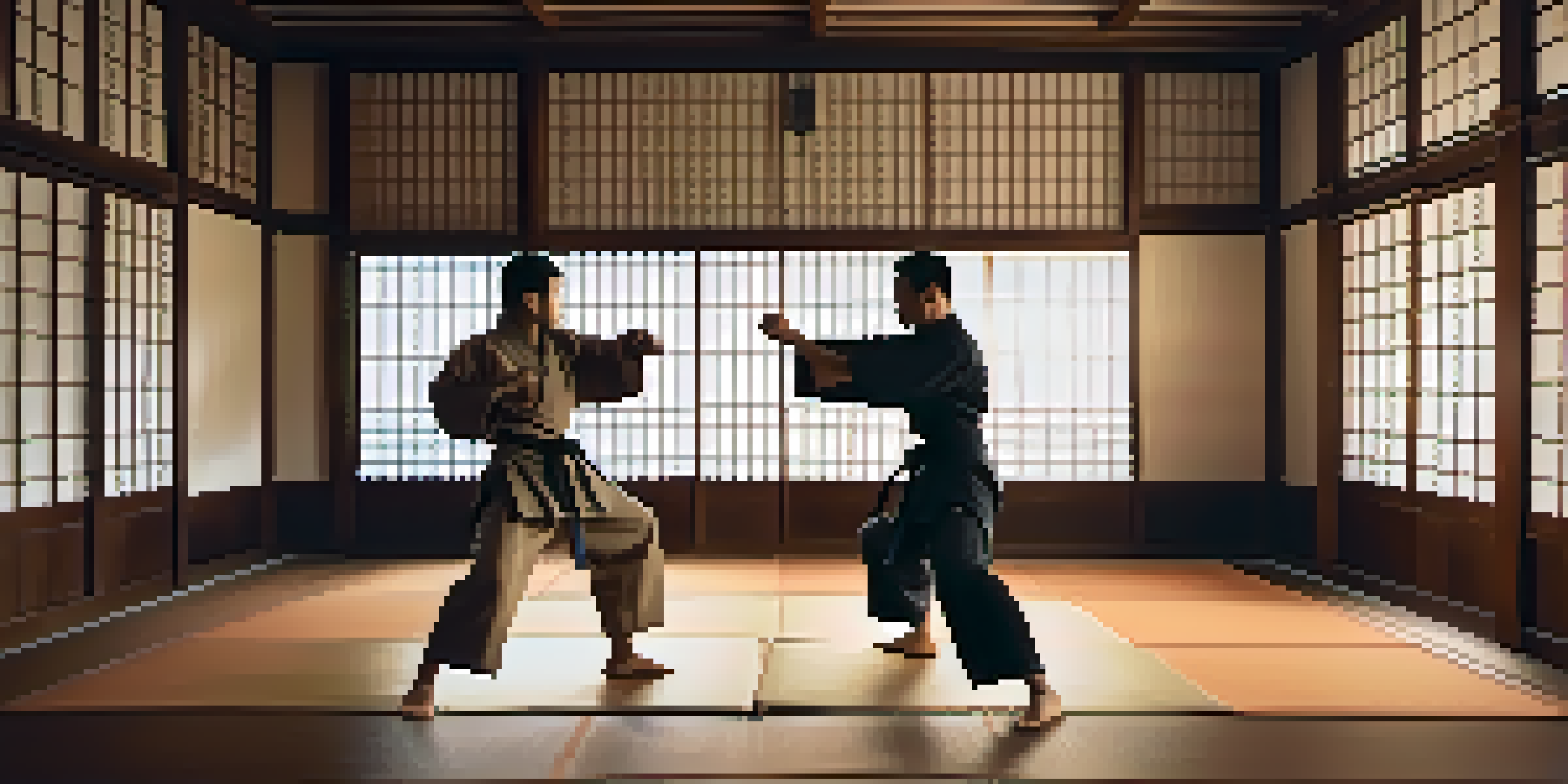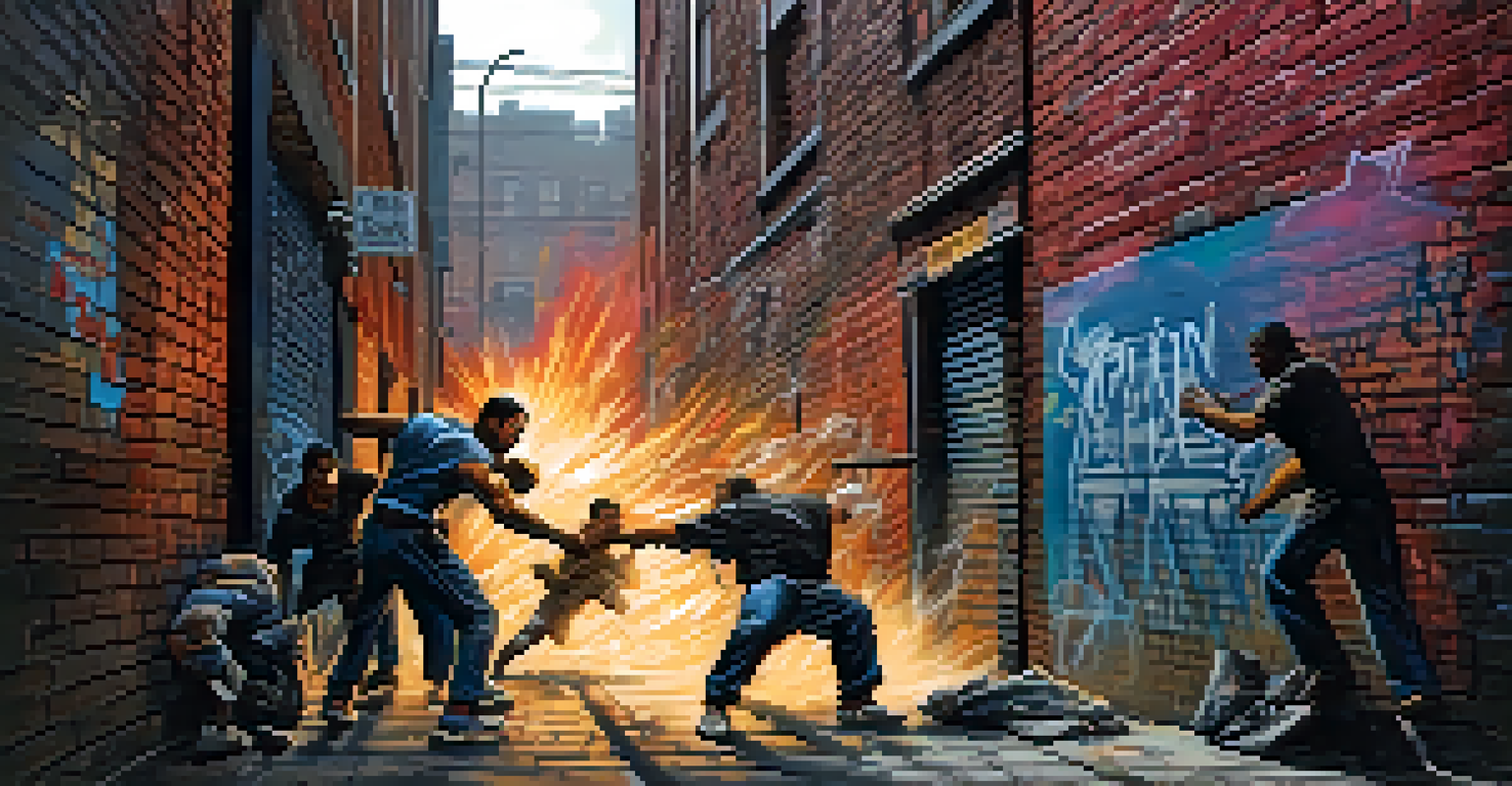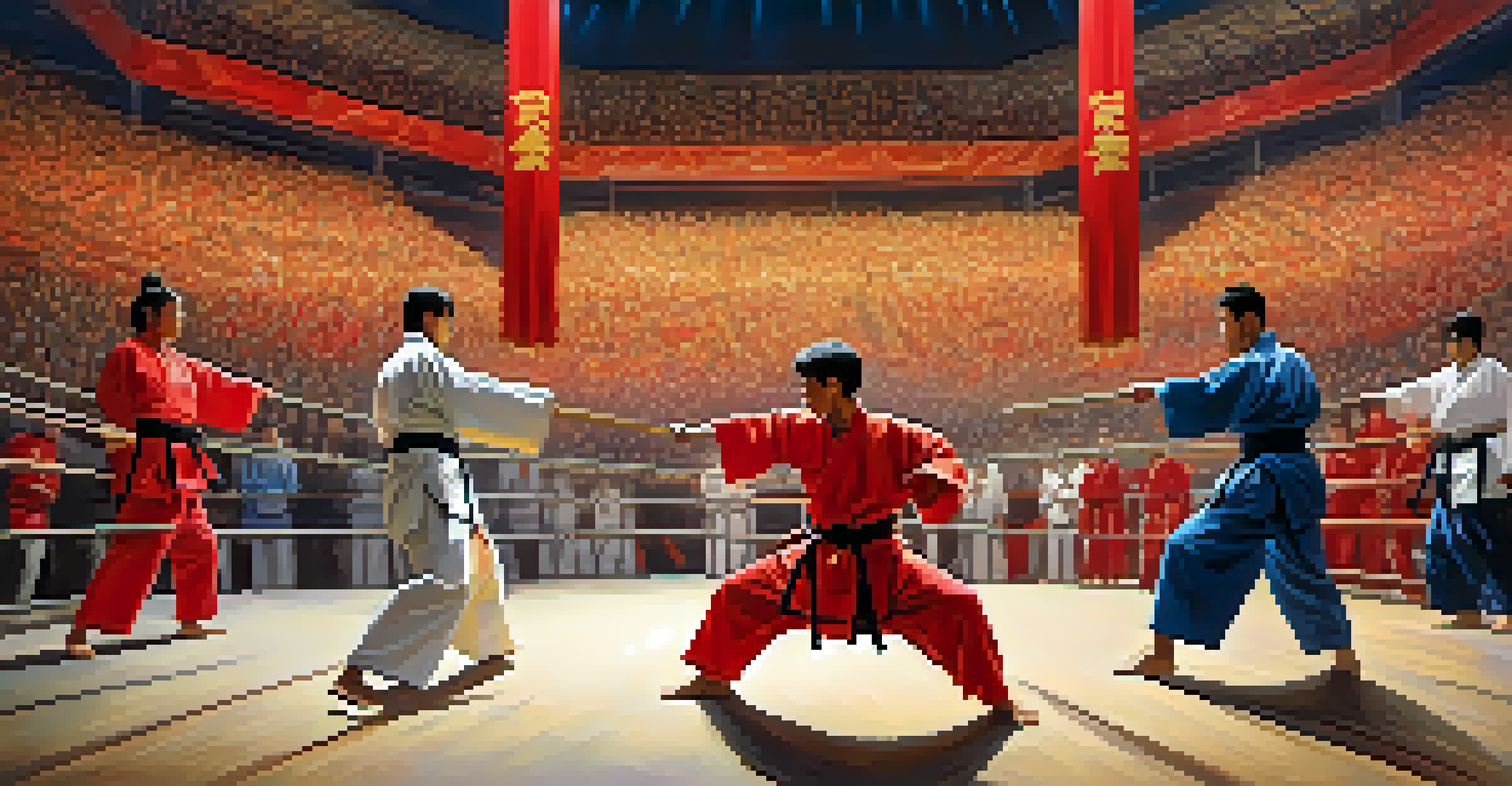Cinematic Techniques: How Martial Arts Fight Scenes Are Crafted

Understanding the Importance of Choreography in Fight Scenes
Choreography is the backbone of any martial arts fight scene. It ensures that every movement looks fluid and believable, drawing viewers into the action. Think of it as a dance; each fighter moves in sync with their partner, making the performance both thrilling and aesthetically pleasing.
Choreography in fight scenes is like a dance; it transforms raw action into a captivating visual experience.
Professional choreographers work closely with directors and stunt coordinators to plan out each sequence. They often incorporate elements from various martial arts styles to create a unique fighting language that enhances the story. This careful planning helps set the tone, whether it's a serious showdown or a playful skirmish.
Additionally, choreography allows actors to portray their characters' skills and personalities. A skilled martial artist might have more fluid movements, while a street fighter might appear more aggressive and erratic. These nuances help shape the audience's connection to the characters.
The Role of Camera Angles in Enhancing Action
Camera angles play a crucial role in how fight scenes are perceived. By shifting perspectives, filmmakers can heighten tension and excitement, drawing viewers deeper into the conflict. For example, a low-angle shot can make a fighter appear more powerful, while a high-angle shot can evoke a sense of vulnerability.

Moreover, the use of close-ups can capture the intensity of emotions during a fight. These shots let the audience see the determination in a fighter's eyes or the fear in their opponent's face, adding a layer of drama that complements the physical action. This emotional connection is vital for keeping the audience engaged.
Choreography Makes Fight Scenes Engaging
Well-planned choreography enhances the fluidity and believability of martial arts performances, captivating the audience.
Dynamic camera movements, such as tracking shots or rapid cuts, add to the adrenaline rush. They create a sense of urgency that mirrors the chaos of a real fight. By carefully selecting angles and movements, filmmakers can transform a simple bout into a cinematic spectacle.
Sound Design: Adding Depth to the Action
Sound design is often an underappreciated aspect of fight scenes. The right sound effects can amplify the impact of a punch or the swish of a kick, making each blow feel more visceral. For instance, a well-timed ‘thud’ can make viewers wince and feel the weight of the action.
In filmmaking, sound design can amplify the emotional weight of a scene, making every punch feel like a thunderclap.
In addition to sound effects, the choice of music plays a significant role in setting the mood. A fast-paced score can heighten excitement, while a more subdued track can create tension. This auditory backdrop helps guide the audience's emotional response to the fight, making them feel every twist and turn.
Moreover, silence can be just as powerful. In some scenes, a sudden drop in sound can create a moment of suspense, allowing viewers to anticipate the next move. By mixing sounds strategically, filmmakers craft an immersive experience that captures the audience's attention.
Editing Techniques That Shape the Fight Narrative
Editing is where the magic happens, transforming raw footage into a cohesive fight scene. Techniques like cutting on action can create a seamless flow, making it hard for viewers to notice the transitions between shots. This technique keeps the energy high and the audience engaged, as they follow the action without interruption.
Moreover, the pace of editing can influence the fight's intensity. Quick cuts can create a frenetic, chaotic feel, while longer shots can emphasize skill and precision. By varying the rhythm, editors can manipulate how the audience experiences the fight, evoking a range of emotions from excitement to dread.
Camera Angles Heighten Tension
Strategic camera angles and movements can intensify the emotional impact of fight scenes, drawing viewers deeper into the action.
Transitions, like fades or wipes, can also serve a narrative purpose. They can signal a shift in time or location, enhancing the storytelling aspect of the fight. Effective editing not only showcases the choreography but also enriches the overall narrative of the film.
Set Design: Creating the Perfect Battlefield
The set design plays a pivotal role in establishing the context of a fight scene. Whether it's a traditional dojo, a gritty alley, or a grand arena, each location contributes to the story. A well-designed environment can enhance the stakes, influencing how characters interact with their surroundings during combat.
Additionally, props can add an extra layer of creativity to fight scenes. From weapons to furniture, these elements create opportunities for unique combat styles. For example, using a chair as a shield or a table as a weapon can lead to unexpected and thrilling moments that keep the audience on the edge of their seats.
Furthermore, the color palette and lighting of the set can evoke specific emotions. Dark, moody lighting might create a sense of danger, while bright, vibrant colors could suggest a more lighthearted or comedic tone. Set design is not just a backdrop; it's an integral part of the storytelling process.
The Influence of Cultural Context on Martial Arts Scenes
Cultural context significantly influences how martial arts are portrayed in film. Different styles originate from distinct cultural backgrounds, each with unique philosophies and techniques. Understanding these nuances allows filmmakers to represent martial arts authentically, respecting the traditions they draw from.
For instance, a fight scene rooted in traditional Japanese martial arts may emphasize discipline and honor, while a scene inspired by Brazilian Jiu-Jitsu might focus on strategy and leverage. By incorporating these elements, filmmakers create a richer narrative that resonates with audiences familiar with these cultures.
Collaboration Ensures Authenticity
Successful fight scenes rely on the seamless collaboration between choreographers, directors, and actors to create a cohesive and captivating narrative.
Additionally, cultural representation can shape audience expectations. Viewers might anticipate specific fight styles or techniques based on their familiarity with a culture's martial arts. By meeting or subverting these expectations, filmmakers can create memorable and impactful fight sequences that engage and surprise.
Collaboration: The Key to Successful Fight Scene Production
Creating a captivating fight scene is a collaborative effort that involves multiple departments. Choreographers, directors, and stunt coordinators must work together to align their visions, ensuring that each element contributes to a cohesive final product. This teamwork fosters an environment where creativity can flourish, leading to innovative fight sequences.
Actors also play a crucial role in this collaboration. Their commitment to training and rehearsal can elevate a scene, as they bring their characters to life through physicality. When actors invest time in mastering their roles, it not only enhances the authenticity of the fight but also deepens the audience's connection to the characters.

Moreover, communication between departments is essential. Regular meetings and discussions help align everyone’s goals, ensuring that the choreography, camera work, and editing all work harmoniously. This synergy is what ultimately transforms a fight scene from mere action into a captivating cinematic experience.